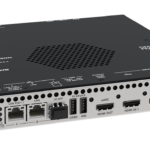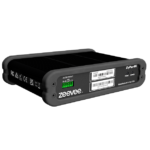AV-over-IP is on track to be — arguably, already is — the backbone of contemporary pro AV integration. By leveraging Ethernet’s ubiquity, AVoIP pushes past the limitations of traditional AV systems and introduces scalable, flexible and cost-effective solutions for integrators and end users.
Commercial Integrator’s 2025 AVoIP Deep Dive report sheds light on this evolving technology, boasting insights from industry experts and data drawn from a survey of the integration community.
To read the full AVoIP Deep Dive report, check out our PDF download. What follows is a summary of key findings from the report.
AV-over-IP Deployment and Adoption Trends in Pro AV
The adoption of AVoIP is steadily growing, according to Sean Wargo, vice president of market insights at AVIXA. “Integrators are using AVoIP in the majority of solutions, but the expansion of that is increasing slowly over time, on average,” he explains. “Some firms are likely to be almost exclusively deploying IP-based systems, while others may not have progressed that far.”
Commercial Integrator’s survey of the integrator community reveals that 70.2% of integrators are fully onboard with or ready to make AVoIP their primary solution, whereas 21.4% remain hesitant but are open to the transition. Only 8.3% self-describe as not being prepared for the shift.
Marty Fornelli, senior design engineer at Diversified, notes the normalization of this technology. He states, “The number of projects that do not use AVoIP technology is very small at this point. The vast majority of projects have at least some elements that leverage the network for signal transport.”
Michael Goldman, principal at Communications Design Associates, reports that AVoIP adoption has gained momentum in the last half-dozen years, as organizations shifted toward scalable, reconfigurable, network-based AV systems. He observes this trend gaining traction, in particular, among ROI-minded enterprise clients.
Key Advantages Driving Growth
Scalability and flexibility are the hallmarks of AVoIP, and they’re leading reasons why the approach continues to gain wider adoption. Dalton Parker, director of sales and marketing at TVS Pro, highlights the role of AVoIP in system architecture, stating, “Rather than mixing and matching products to fill gaps, AVoIP provides a unified, flexible solution that scales easily. It simplifies system architecture while expanding possibilities for integration and long-term growth.”
Key Benefits of AV-over-IP in Pro AV
- Scalability and flexibility: A thoughtfully designed AVoIP framework allows systems to grow incrementally without significant upgrades.
- Interoperability: Standards-based approaches simplify integration and encourage hardware compatibility.
- Remote capabilities: AVoIP solutions feature remote monitoring and IT toolset integration, enabling faster, more proactive system management.
For clients whose projects entail specific demands, Jason Jaworski, CTS, co-founder of Unassailable Solutions, emphasizes the cybersecurity benefits of AVoIP. “AVoIP infrastructures can be hardened to meet rigorous security standards, incorporating encryption, network segmentation and other best practices to comply with national security frameworks like ICD-503, RMF and NIST SP800-53,” he explains.
Ongoing Challenges
Although AVoIP offers numerous advantages, it is not without its challenges. One example involves the need for alignment between AV teams and IT teams; another challenge centers on the complexities of network management and infrastructure. Ultimately, though, Parker views this as an opportunity to foster collaboration. Integrators can consult with and educate IT teams on AV terminology and system demands.
Jaworski adds that success hinges on meticulous upfront design and requirement analysis. Clear communication with stakeholders and careful expectations management are crucial to ensuring success. Another possible strategy to maximize the likelihood of a successful outcome is leveraging preconfigured solutions from industry-leading manufacturers.
Market Trends and RMR Opportunities
Looking at AVoIP adoption across market segments, we see a story of widespread acceleration. In terms of percentages of projects across segments leveraging AVoIP technology, leading markets include corporate (77.1%), education (73.5%) and entertainment/performance (56.6%). Wargo identifies corporate environments as early adopters because of IT departments’ involvement in system deployment and management.
Parker, meanwhile, observes growth in education, especially on college campuses, where scalable, campus-wide systems reduce complexity and enable proactive monitoring.
The rise of recurring monthly revenue (RMR) models is another significant trend that CI covers regularly. Parker explains that AVoIP is transforming the service landscape by facilitating proactive system monitoring and diagnostics. “Instead of waiting for something to break, we ensure it doesn’t,” he says. “That shift isn’t just good for business — it’s exactly what clients have been asking for.”
The Road Ahead for AV-over-IP in Pro AV
Looking forward, AVoIP is expected to reach greater levels of standardization. Goldman predicts customers will demand streamlined systems, which will drive the market toward unified protocols. Parker anticipates the saturation of current protocols will lead to meaningful consolidation, stating, “Ultimately, simplicity and reliability will win. Clients want streamlined systems.”
For integrators, education and adaptability remain paramount. Lincoln King-Cliby, commercial market director at ControlWorks Consulting, stresses the importance of hands-on learning in networking and IP fundamentals. However, he says that such training has been slow to rebound post-pandemic.
Final Thoughts
The AVoIP era is already here, reshaping the AV landscape with scalable, flexible and secure solutions. Wargo sums it up best when he says, “We’ve already passed the tipping point.” He continues, “More than half of projects are done with IP network distribution, control and management.”
Integrators whose businesses adapt quickly, bridge AV/IT gaps and position themselves as strategic partners will thrive in this new era. “AVoIP rewards early adopters,” Parker concludes. “The time to lean in is now.”
Check out our full Deep Dive report in handy downloadable format.

















